Nikon AF-S VR-Nikkor 70-200mm f/2.8 G (IF)
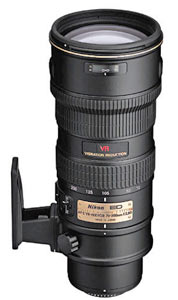 This lens is Nikon’s version in the professionally specified and very popular 70-200 range. It incorporates Nikon’s own variety of stabilisation, in this case called VR (Vibration Reduction) and, as with other stabilised lenses, there are two modes. The Nikon however, works slightly differently. We take a look here at the pros and cons of this offering in a very competitive market place.
This lens is Nikon’s version in the professionally specified and very popular 70-200 range. It incorporates Nikon’s own variety of stabilisation, in this case called VR (Vibration Reduction) and, as with other stabilised lenses, there are two modes. The Nikon however, works slightly differently. We take a look here at the pros and cons of this offering in a very competitive market place.
Specification
- Focal length 70-200mm
- Angle of view 34.3-12.3degrees
- Max Aperture f/2.8
- Filter size 77mm
- Construction 21 elements in 15 groups
- Focus type Internal SWM
- Closest focus 1.5m/5ft
- Size 87x215mm
- Weight 1.47kg
- Mount Nikon,
- Tripod Bush Yes, supplied
- Price £1500
Build and handling
This lens seems, on first handling it, to be slimmer and lighter than the opposition. It is somewhat of an illusion though, probably enhanced by the low profile tripod collar and the physically smaller Nikon mount.
The first 50mm of the lens are plain except for a single white location dot. This area does however include a non-removable tripod collar that blends in so well with the lens that it isn’t noticed from above. From below there is a low profile tripod bush and adjustment knob.
In front of this collar, on the left side of the barrel, is an array of switches. There are four, all single movement units, that control, from top to bottom, Manual/Autofocus, Focus limiter, VR on/off and VR Normal/Active. The zoom ring comes next, marked at 200, 135, 105, 80 and 70mm. In total, this ring is some 29mm wide, part of which is ribbed just enough to be usable. There is then a short gap before the manual focus ring, a wider, stepped affair which would make for easy manual focussing if it were not so far forward.
A bayonet fit petal hood with a positive click lock is supplied and fits around the 77mm filter thread.
In use, this lens is quite comfortable, if a little front heavy on lighter camera bodies like the D50/70/s and would need the Pro style bodies of the D1/D2 series to be what I would call well balanced. The low profile bush seems well able to cope with this though.
Apart from optical quality, which I will come to later, the jewel of this lens is the Vibration Reduction system. Unlike other systems, it does not require switching from static shots to panning mode, detecting the change automatically, and it classifies this sort of photography as Normal. This, to me, seems a sensible classification! The mode switch, lowest of the four mentioned, only needs to be turned to Active if and when the whole photographer/camera combination is on the move such as in a moving vehicle or, as one photographer put it, "swaying atop an elephant!" The VR system can be turned off completely for tripod use. The system, Nikon claims, is good for three stops and I found no evidence to refute this claim. It all worked quietly and well.
The focus restrictor is another handy device, stopping the lens from focusing closer than 2.5m, useful when shooting through wire mesh or bushes! It also helps reduce the autofocus response time, which is extremely rapid to start with. The autofocus also has full time manual override incorporated and the lens does not change its length or orientation during operation.
Optical Quality
Various tests, both by myself and others, have consistently found this lens to be one of the top performing lenses available today. This is true, not just for similar zooms but across the whole spectrum of optics on the market. All forms of aberration, astigmatism and the like are so well controlled that it would be futile for me to try and pick holes in it! Oh, and it’s pin sharp!
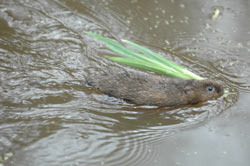 | 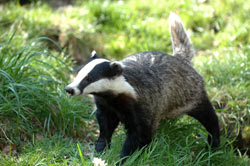 |
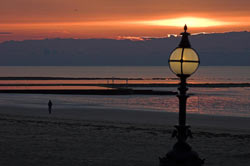 |  |
 | Water Vole transporting a crocus plant to feed it’s young. 1/100sec @ f/3.5 |
Click on the comparison photos below to see full size versions.
 70-200mm at 200mm f/8 | |
 70-200mm at 70mm f/2.8 |  70-200mm at 200mm f/2.8 |
Below is our lens test data. To find out how to use these graphs look at this article: How we test lenses
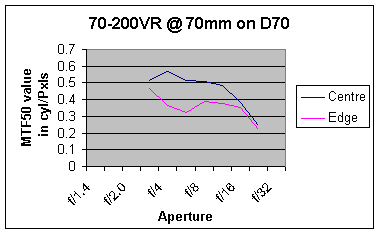
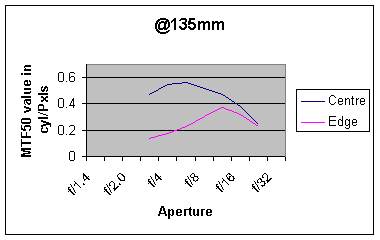
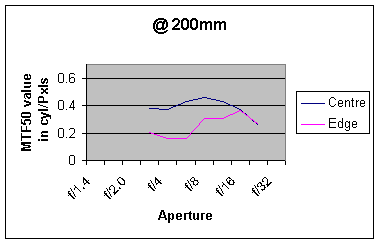
Verdict
In the competitive arena of mid-range zooms, this is the Michael Schumacher. Others come close in some areas, but this is the complete package, coming out top in the fields of optical quality, handling and stabilisation. If you have a camera that this lens will fit, this is the lens to have.
In summary the main positive points of the Nikon AF-S VR-Nikkor 70-200mm f/2.8 G (IF) are:
![]() Optical quality superb
Optical quality superb
![]() Vibration Reduction system
Vibration Reduction system
![]() Good handling
Good handling
Negative points are:
![]() Balance on smaller bodies (minor)
Balance on smaller bodies (minor)
![]() Low profile tripod mount may not clear some QR systems.
Low profile tripod mount may not clear some QR systems.
![]() Price, although well discounted in the ePHOTOzine shop.
Price, although well discounted in the ePHOTOzine shop.
Check the latest price of the Nikkor 70-200mm here
Test by Ian Andrews www.wildaboutkent.co.uk
Add your message
Please login here or if you've not registered, you can register here. Registering is safe, quick and free.
photodo Stats
428 MTF tests
74 in-depth photodo reviews
100+ users join each day
Help the lens community by reviewing or rating a lens today via our lens search
Latest Lens Reviews
- Chinon 28mm f/2.8 Vintage Lens Review
- Canon EF 70-200mm f/4L IS II USM Lens Review
- Samyang AF 85mm f/1.4 EF Review
- Sigma 70mm f/2.8 DG Macro Art Review
- Samyang AF 24mm f/2.8 FE Review
- Meike 50mm f/1.7 Review
- Tamron 70-210mm f/4 Di VC USD Review
- Lensbaby Burnside 35mm f/2.8 Review
- Asahi Super Takumar 50mm f/1.4 Review
- Asahi Super-Multi-Coated Takumar 135mm f/3.5 Review

